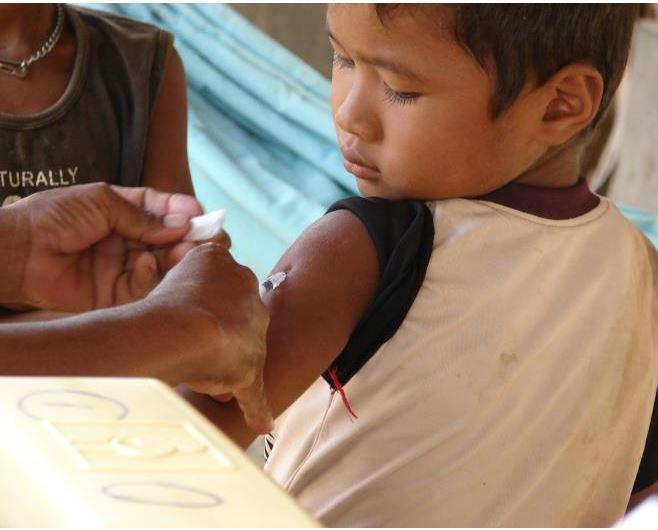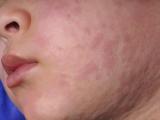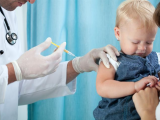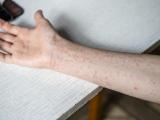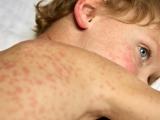A study published yesterday in Morbidity and Mortality Weekly Report (MMWR)details a measles outbreak that sickened 57 people at a Chicago migrant shelter this year and how a prompt and coordinated mass-vaccination campaign helped contain it.
Measles is a highly contagious respiratory virus that can cause severe complications, hospitalization, and death. In 2000, the United States declared measles eradicated, but cases still occur because of ongoing global spread and undervaccination, noted the Centers for Disease Control and Prevention (CDC)-led study team. "Receipt of 1 and 2 doses of measles vaccine is 93% and 97% effective, respectively, in preventing measles."
Since August 2022, they said, about 41,000 migrants have arrived in Chicago from the southern US border, 88% of them from Venezuela, which has seen a decline—from 96% in 2017 to 68% in 2021—in routine childhood vaccinations, including the measles vaccine.
First reported case was in 1-year-old boy
On February 22, 2024, about 12,000 people were staying in 27 temporary migrant shelters run by the city of Chicago. On that date, the largest of them—the affected shelter, called "shelter A" in the report—was housing roughly 2,100 people, with 500 or more staying in some rooms. In addition to congregate sleeping areas, the migrants shared a dining area and bathrooms.
Given the congregate nature of the setting, high transmissibility of measles, and low measles vaccination coverage among shelter residents, measles virus had the potential to spread rapidly among approximately 2,100 presumed exposed shelter residents.
The first case of the outbreak was identified in a 1-year-old boy living at the shelter. He developed a rash on February 26 and was hospitalized the next day for suspected measles.
The boy had arrived in the United States more than 5 months earlier and had received one dose of measles, mumps, and rubella (MMR) vaccine 5 weeks before symptom onset; he had not traveled recently or had a known exposure to measles. The Chicago Department of Public Health (CDPH) confirmed the infection on March 7.
"Given the congregate nature of the setting, high transmissibility of measles, and low measles vaccination coverage among shelter residents, measles virus had the potential to spread rapidly among approximately 2,100 presumed exposed shelter residents," the researchers wrote.
CDPH worked with state and local health departments, health care facilities, city agencies, and shelters on outbreak investigation and response. On March 8, CDPH began case-finding efforts and launched a mass-vaccination campaign at the shelter, vaccinating 882 residents and verifying previous vaccination for 784 over 3 days.
"These activities resulted in 93% measles vaccination coverage (defined as receipt of ≥1 recorded measles vaccine dose) by March 11," the authors said. "By May 13, a total of 57 confirmed measles cases associated with residing in or having contact with persons from shelter A had been reported."
As of May 13, CDPH had held roughly 130 mass vaccination events at 25 Chicago migrant shelters and administered about 9,500 MMR vaccine doses, prioritizing the shelters that had previously received residents from shelter A and those housing pregnant women and young children. "This strategy included additional vaccination events at shelter A beginning on March 25, with a focused second-dose vaccination campaign during April 8–10," the researchers said.
Index infection likely acquired locally
Most infections (72%) occurred in unvaccinated residents, and 28% were diagnosed in those who had received at least one measles vaccine dose at least 21 days before the first known measles exposure.
The risk for transmission within and outside of shelters can be mitigated by maintaining high MMR vaccination coverage among both established and newly arrived residents.
Fifty-two of the 57 infected people were shelter residents, while three were staff workers, and two were community members. The median patient age was 3 years. Two cases occurred among people who had lived at the affected shelter but had resettled or transferred to less-crowded shelters with private sleeping areas after March 7; no secondary cases were identified at those shelters.
Fifty-one people (89%) were hospitalized for isolation and/or measles complications, but no deaths were reported. The last known exposure at the affected shelter was April 5. As of May 13, the same measles genotype D8 sequences had been identified from 52 case specimens; the remaining 5 isolates couldn't be sequenced.
"Although persons in the community affected by this outbreak had recently arrived in the United States, the index patient’s arrival in Chicago months before illness onset suggests that the disease was acquired locally," the authors concluded. "The risk for transmission within and outside of shelters can be mitigated by maintaining high MMR vaccination coverage among both established and newly arrived residents."
